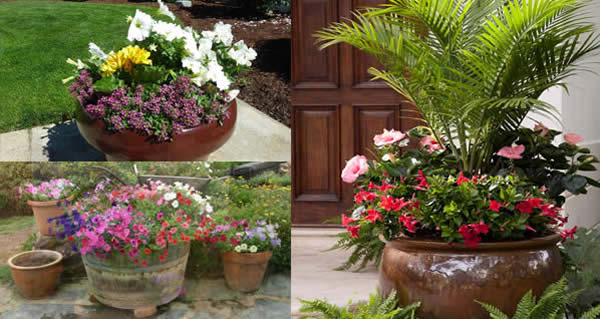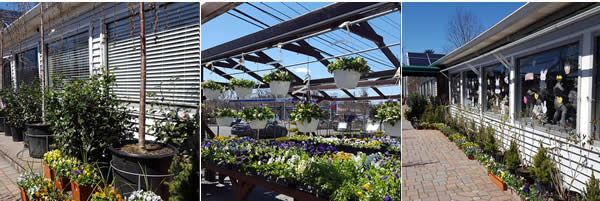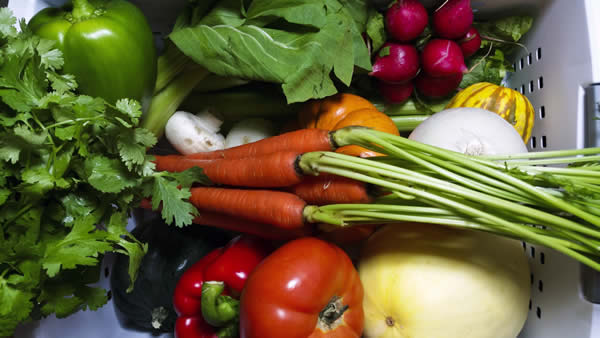
Planning an outdoor celebration for Memorial Day? Show your patriotism by planting some beautiful containers to adorn your deck in the traditional colors--red, white and blue!
A good way to design these containers is to choose one plant for the center or back of the container that can remain in the pot indefinitely and filling in with foreground or perimeter plantings that can be changed with the seasons. Be sure to choose a pot large enough to accommodate the plants selected for it. If the pot does not have drainage holes, be sure to drill some before planting.
Dwarf bottlebrush (red), hibiscus rosa-sinensis (red or white), sea lavender (blue), butterfly bush (blue), kangaroo paw (red) or 'Flower Carpet' Roses (red or white). The choices are a little more limited if your pot will be placed in a shady area, but a gardenia or a dwarf red-leaf Japanese maple would work well.
Some good choices for foreground plants or plants that will drape over the sides of the sunny container would be petunia (red, white or blue), million bells (red, white or blue), red or blue salvia, verbena (red, white or blue), vinca (red or white) or ageratum (blue or white). Shady selections would include impatiens (red or white), begonia (red or white), lobelia (blue or white), heuchera (a red-leaf or white-leaf variety) or coleus (a red-leaf variety).
Choose a good quality potting soil. Make sure when potting your plants to compress the soil well; this will get rid of air pockets that will keep water from reaching portions of the soil and will also minimize settling of the soil. Be sure to allow enough room to water by leaving a couple of inches between the top of the soil and the top of the pot.
After your containers have been planted a few weeks, feed them with a good fertilizer to keep them blooming and growing well. Use the recommended amount and frequency suggested for the fertilizer (more and/or more often is NOT better).
With the proper care, your container will continue to bloom until July 4th and beyond. When fall comes, the filler plants can be removed and replaced with cool-season annuals of your choice.
Click to print this article.

A flower garden, dangling like a colorful jeweled earring from the eave of your home. Yes, a hanging floral bouquet, the hanging basket--filled full to the brim with flowers and plants from the season, whether that is spring, summer or fall.
A design concept is important for you to consider when building your own hanging basket. You will need to choose a style or theme. For example, perhaps you want all of the same kinds of plants or flowers, or you might choose to have a single color scheme, while others might choose complementary colors or contrasting colors. A hanging basket with all flowers can be fun, and a mixed basket with flowers and foliage plants can be even more interesting.
A hanging basket makes a wonderful statement when it contains both upright and trailing plants.
Make sure, however, that the plants that you choose for the upright feature will remain within the scale of the container that you have chosen.
Did we mention containers? There are many choices of containers, too.
Wire baskets lined with moss, plastic pots with built in hangers, pots hanging with woven ropes--your ultimate choice will depend on the look that you are creating.
So, you've decided upon your theme, have an idea of the plants that you want and have chosen the container. Excellent.
Next you need to prepare your potting mix. Select a high quality potting mix and mix in a controlled-release fertilizer to give it a good start.
Also, remember that moisture retention is frequently a problem with hanging baskets (and all containers, for that matter), so also mix in a soil polymer that will hold on to the moisture between waterings.
If you have chosen to create a succulent hanging basket, you will need cactus mix, but probably not the slow-release fertilizer or the moisture polymer.
Planting is the next step. Fill your container about 2/3 to 3/4 full with the potting mixture. Carefully remove your new plants from their nursery containers and place them in the container. Don't hesitate to move them around until you are thrilled with the arrangement.
Keep in mind which ones are upright growers, and place them in the center. Trailing flowers/plants should be near the edge, of course.
Once the plants are arranged to your satisfaction, fill in between plants with your potting mixture and water well. Remember that, even if you did use the moisture retention polymer, containers dry out far more quickly than plants in the ground. You will need to water several times a week or even more frequently in hot weather.
What's next, you wonder? Watching your own creative design grow to maturity.
Take your time to come into the garden center and look through our selection of flowering and foliage plants. We'll be delighted to help you become a great hanging floral bouquet designer!
Click to print this article.

















